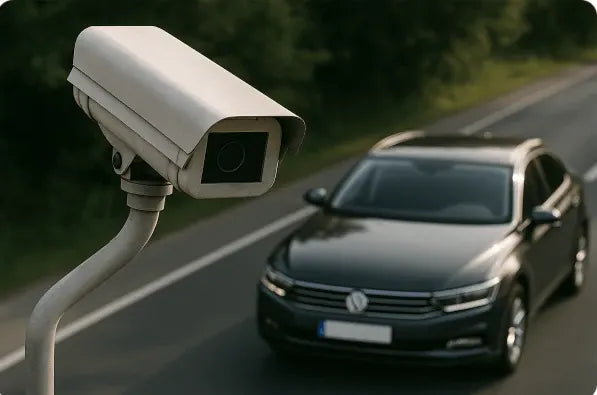How Different Camera Angles Affect License Plate Visibility: A Visual Breakdown
Most drivers don’t think twice about how a traffic camera sees their license plate. But the truth is, camera angle matters more than you might think. Whether it’s a red-light camera, a toll gantry, or a speed trap setup, the angle of view plays a massive role in how clearly your plate is captured. In this post, we’ll break down how viewing angles affect plate visibility—and how smart cover design can help protect your privacy in a compliant, optical way.
Why Angle Matters
Traffic enforcement cameras aren’t always placed directly behind your vehicle. In fact, most are mounted above the roadway or off to the side, giving them a steep or skewed viewing angle. At these off-center views, even subtle optical changes can distort how a plate appears—especially when combined with glare, lighting, or lens-enhanced covers.
Common Camera Angles and Their Effect
- 0° (Directly Behind) – Standard tailing position, such as a police cruiser or trailing vehicle. A license plate is clearly readable with or without any covers. Most optical distortion has little to no effect here.
- 15°–30° (Roadside/Shoulder Mounted) – Common angle for speed cameras or local red-light systems. At this angle, curved light and lens diffusion can begin to reduce clarity.
- 45° (Overhead Intersection Camera) – Typically used in red-light enforcement or toll systems. Plates are viewed from above and behind, creating a steep oblique angle. Optical lens distortion at this angle can create a blur or warp that confuses camera software.
- 60°+ (Bridge, Drone, or Elevated Pole) – These are rare but aggressive angles. Readability drops significantly even with standard lighting. Lens covers using refraction or distortion patterns may redirect or scatter incoming light here.
Visual Simulation of Viewing Angles

The image above shows how legibility degrades as camera angles increase—from fully visible at 0° to completely obscured at 45° due to lens-based distortion.
This side-by-side view shows how a traffic camera positioned directly overhead captures a completely blurred plate, while a view from directly behind the car shows the plate perfectly legible. This is a fundamental principle behind how Camera Stopper's lens covers are designed to protect from the angles cameras are most likely to use.
Overhead vs Rear Camera Comparison

This image shows that Traffic Cameras (often Toll Cameras) take photos directly above your vehicle. The Camera Stopper Photo blocker ensures that all images from traffic cameras mounted above are completely blurred out. However, when viewed from directly behind your plate is completely legible. It's the magic of our proprietary Nano Lens technology.
Why Camera Stopper Covers Are Designed This Way
Camera Stopper’s lens pattern isn’t random. It’s optimized to blur plate visibility from specific oblique angles where cameras are most likely to be mounted. The distortion is optical, not digital, which means there’s no electronics or active systems—just pure lens physics doing the work.
From directly behind, your plate remains readable to human drivers, toll stations, and parking attendants. But from elevated or side angles, the clarity drops just enough to disrupt machine readability. That’s by design.
Final Thoughts
Understanding camera angles gives you a deeper insight into how real-world surveillance operates. If you want protection that works with the laws of light and vision—not against them—Camera Stopper is built for exactly that.
Camera Stopper Nano Lens Cover
Engineered for privacy. Designed for legality on off roads. Proven to distort visibility at angles used by most traffic cameras.


